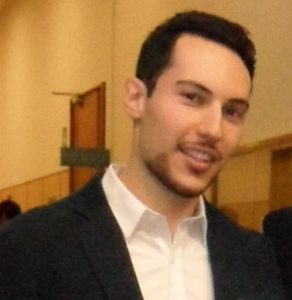 Hometown: Perugia, Umbria, Italy
Hometown: Perugia, Umbria, Italy
Current address: Düsseldorf, Germany
Project: Multipartite quantum communication systems
Brief biography:
I was born in 1992 in a rather quiet city placed right in the center of the Italian peninsula. My father is a local while my mother is Canadian, thanks to her I am also a proud Canadian citizen.
Since my infancy I have always been interested in scientific stuff, picking up this passion from my father (an engineer). For this reason I obtained a scientific high school diploma in my hometown. Nevertheless, I will always be thankful to the Italian education system which allowed me to have a broad preparation trespassing the scientific area and embracing subjects such as: Italian and English literature, history of art, Latin and philosophy. Having come in contact with these subjects helped me expand my passions and interests beyond science.
I obtained my Bachelor’s degree in Physics at the Università degli Studi di Perugia in 2014, with a review thesis on entanglement entropy.
I then moved to Milan for my Master’s studies (Università degli Studi di Milano). There I had the chance to really follow my personal taste regarding physics topics having a wide variety of courses to chose from, with few constraints. I ended up with basic but solid knowledge about: quantum information, group theory, quantum field theory, theory of fundamental interactions, differential geometry, advanced general relativity, super-symmetric theories, statistical mechanics.
Master’s thesis glimpse:
“Probing the spectral density of structured environments”
My thesis relies on some fundamental concepts of quantum estimation theory. The goal is to characterize the structured environments inducing dissipation and decoherence on open quantum systems. In particular, we focus on environments modeled as thermal bosonic reservoirs, composed on an infinite number of harmonic oscillators and displaying a specific spectral distribution (Ohmic, Sub-Ohmic and Super-Ohmic) in the continuous-mode limit.
The aim is to uncover the precision in estimating the true value of the spectral distribution’s parameters. To this end we probe the structured environment with a single-mode quantum harmonic oscillator. The probe state following the interaction with the environment is now carrying some information about its spectral density. By performing appropriate quantum measurements onto the probe final state, we are able to extract information on the spectral density parameters. We optimize the estimation of the spectral parameters by employing the tools of quantum estimation theory (Cramer-Rao bound, QFI) onto the probe final state. In particular, we optimize over the parameters describing the initial Gaussian state of the probe and over the quantum measurement performed.
QCALL network:
Upon completing my Master’s studies in 2017, I wanted to continue working in the academic world by taking a PhD on quantum information/quantum cryptography topics. I looked for one that would give me the possibility to work in an international environment and expand my knowledge both on the scientific and cultural side. In the end I chose to join the newly born QCALL network, which I consider perfectly suited to what I was seeking.
Updates on the project:
In my first work for the project (article here), we analyze the security of two multipartite quantum key distribution (QKD) protocols, specifically we introduce an N-partite version of the BB84 protocol and we discuss the N-partite six-state protocol. We compare the performances of the two protocols both for finite resources and infinitely many signals.
Thanks to a fruitful collaboration with our partners at the University of Vigo, we performed a detailed analysis of the Twin-Field-type QKD protocol proposed by Curty et al. In particular, we investigated the protocol’s performance in a practical scenario which accounts for: imperfect devices, a finite number of decoy intensity settings and asymmetric losses affecting the quantum channels of Alice and Bob. This work led to a published article and its follow-up.
Taking inspiration from the Twin-Field QKD protocol just analyzed, we extended its main idea to the multipartite scenario. We thus developed a new conference key agreement (CKA) where the users simultaneously distill a secret conference key through single-photon interference. The new CKA is better suited to high-loss scenarios than previous multipartite QKD schemes and it employs for the first time a W-class state as its entanglement resource.
We performed the first ever quantum CKA experiment that implements the multipartite BB84 protocol we had previously introduced. We also contributed to writing a complete review on CKA.
Finally, we addressed multipartite device-independent (DI) protocols and derived new important results towards tight security proofs of DI conference key agreement and DI randomness generation protocols.